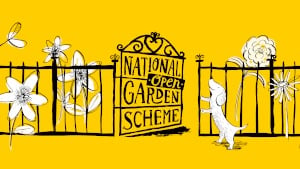About Ilmington Manor
Ilmington Manor occupies some fifteen acres in the centre of Ilmington, a north Cotswold village of great antiquity and charm. The Manor is a rambling Elizabethan manor house, built in the 1590s for Sir Thomas Andrew.
The house had its ups and downs over the years and fell into neglect in the 19th century until a new owner in the 1890s started restoring the property. In 1919 his widow sold the house to the current owner’s grandfather, Spenser Flower, a member of the Stratford-on-Avon brewing family, whose wife, Ella Lowndes, laid out the bones of the gardens as we now see them. Since then the house has been beautifully restored.
The house is built in a local vernacular style in Cotswold stone. The original facades and much else remain intact. Cotswold roof slats are laid in a pleasing undulating effect, showing no trace of the recent renovation.
The gardens, originally a paddock and an orchard, were laid out mainly in the 1920s with features typical of that time – a formal rose garden, a topiary garden and a stone summer house. After the present owner Martin Taylor took over from his bachelor uncle Dennis Flower in 1988, he and his late wife, the artist Miranda Brook, continued the programme of improvement. The garden continues to evolve.
The garden in general
The garden has a peaceful and deeply English character that matches its setting. Near the house there are formal elements – roses, topiary, statuary. Some of the stonework, as in the house, makes use of materials rescued from houses being demolished in the 1920s. The lawns then stretch away to the less formal areas, dominated by mature trees. Across the lane the atmosphere become less formal still.
Spring is an intensely colourful season, with Chionodoxa, bluebells, snowdrops, and daffodils in sweeps, among other bulbs. June is another high point when the roses and herbaceous plants are at their best.
The garden was described in Country Life in 1988. Much has changed since then but the structure remains. This is not a tightly controlled garden. Trees in particular are allowed their full reach. The following account was written in August and gives particular attention to trees.
Near the house
The drive up to the house is lined with mature hornbeam. On the right hand side is the rectangular pond garden. The pond is small, square and raised, with water lilies. Elephant’s ears (Bergenia cordifolia) are planted effectively around the perimeter. Other shrubs include roses, clematis and different types of magnolia.
We move into a courtyard where a large fig grows against the house wall. Other climbers in this area include the colourful Actinidia kolomikta. Moving round we reach the rose garden with standard and shrub roses standing above limestone paving. Nearby is a summer house dating from 1924.
The garden rises gently from the house. A little way up in the centre of the Rose garden is a striking armillary sphere by David Harber, essentially a sundial based on a model of objects in the sky, surrounded by some imaginative topiary and a long rectangular area of yew hedging .Elsewhere in the gardens are sculptures of a Unicorn and Giant Egg by the renowned sculptress ,Felicia Fletcher.
Lawns and trees
The formal garden area includes a number of straight lines of sight, some of them running between hard features at either end and defined by beds of mixed planting. There are large areas of calming lawn.
A characteristic feature of the garden is the range of trees and shrubs, many dating from the 1920s and therefore fully mature. Two Scots pines stand near the entrance. Nearby is a large cornelian cherry (Cornus mas) with edible fruits, a tree once planted much more widely than today. Other large trees include liquidambar, walnut, large-leaved lime and a Katsura tree. Smaller ones include a paper-bark maple with intensely coloured peeling bark, a group of Himalayan birch and a medlar. A swamp cypress, planted in 1989, is growing strongly. A copper unicorn surveys the scene from a quiet corner.
Towards the far side are several magnolias and also a black, fruit-bearing mulberry. Close to a cottage entrance we meet a small tree with rose-like white flowers in late summer. This is Eucryphia x nymansensis. Nearby is a quiet enclosed area, once the Dutch garden and now devoted to yew hedging and lawn.
Over the lane
We cross over the lane and enter an area which occupies the larger part of the property and was once an orchard with stew ponds. This has quite a different feel, with rough grass, two lakes and an abundant planting of trees. The views across to the church and dower house and up to the nearby hills are deeply satisfying.
Near the entrance is a small and quite unusual line of Italian alder, together with field maple, a group of hazel, an oak and a silver birch. Across the lake an upright hornbeam is prominent, together with another mature oak, a Norway maple, cut-leafed beech, and a line of Scots pines. Willows are everywhere, notably a large crack willow on the bank of the right-hand lake.
Here is a garden rich in family associations and deeply evocative of English country life.

.jpg)
.jpg)
.jpg)
.jpg)
.jpg)
.jpg)
.jpg)
.jpg)
.jpg)
.jpg)
.jpg)
.jpg)
.jpg)
.jpg)
.jpg)
.jpg)
.jpg)
.jpg)



.jpg)
.jpg)
.jpg)
.jpg)